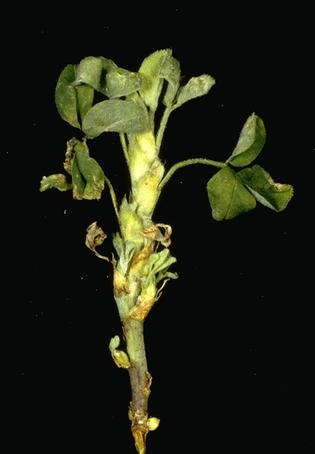By Michelle Leinfelder-Miles
A crop consultant brought in some alfalfa plants and asked if I could help identify the problem. In the field, he was observing stunted plants with shortened internodes and suspected stem nematode (Ditylenchus dipsaci). What seemed different this year is that he was seeing these stunted plants intermingled among healthy plants, and in the past, he was accustomed to seeing stunted plants in groups.

Nematodes are microscopic roundworms that use their stylet, or needle-like mouthpart, to puncture plant cells and suck out their contents. The alfalfa stem nematode lives and feeds in the stems and crown of the plant. Symptoms of infection include plant stunting, shortened internodes, and swollen buds (Figure 1), and white flagging where stems lack chlorophyll (Figure 2). Identification of stem nematode can be done under a dissecting microscope by cutting pieces of stems and the crown in a petri dish with water. I took this picture using my smartphone through the eyepiece of the microscope (Figure 3). The stem nematodes are indicated with the blue arrow; they are the almost-translucent wiggly lines emerging from the piece of stem.
Stem nematodes can be a perennial problem in California alfalfa. (See a previous article on the UC Alfalfa and Forage News blog.) They are a particular problem in the spring when the weather is cooler. As temperatures warm, the nematodes recede to the soil and go dormant until cool weather returns. They can cause complete plant die-back, leaving open areas in the field where weeds can become a problem. Unfortunately, management of this pest is challenging. Varieties have varying levels of resistance, but even with a highly-resistant variety, it can be typical to have susceptible plants next to healthy plants within a stand. For this reason, in an area where stem nematodes are a problem, a grower should plant nothing less than a highly-resistant variety. It is important to plant clean seed. Using proper sanitation methods is also advised and would include not moving equipment and wastewater from infected to clean fields, and also not applying manure from cattle fed with infected stem nematode hay to clean fields. Stem nematodes have a limited host range, so rotating out of alfalfa for at least 2 years can help to reduce the problem, but longer rotations (4 years) might be advised under severe infestations. Rotation crops could include small grains, corn, or dry beans. There are no registered nematicides for stem nematode.